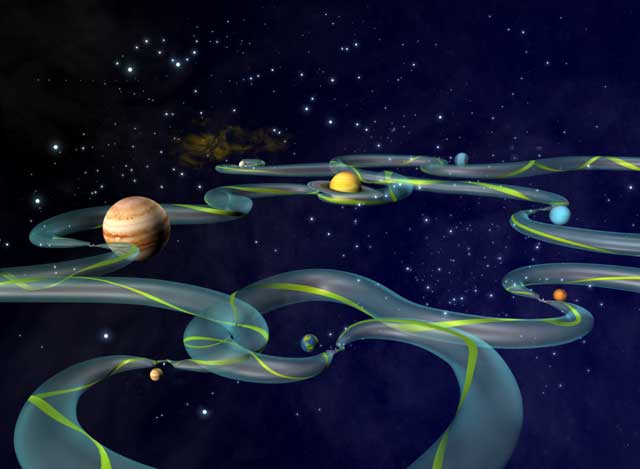
An accurate method for spacecraft navigation takes a leap forward today as the National Physical Laboratory (NPL) and the University of Leicester publish a paper that reveals a spacecraft’s position in space in the direction of a particular pulsar can be calculated autonomously, using a small X-ray telescope on board the craft, to an accuracy of 2km.
The method uses X-rays emitted from pulsars, which can be used to work out the position of a craft in space in 3D to an accuracy of 30 km at the distance of Neptune. Pulsars are dead stars that emit radiation in the form of X-rays and other electromagnetic waves. For a certain type of pulsar, called ‘millisecond pulsars’, the pulses of radiation occur with the regularity and precision of an atomic clock and could be used much like GPS in space.
The paper, published in Experimental Astronomy, details simulations undertaken using data, such as the pulsar positions and a craft’s distance from the Sun, for a European Space Agency feasibility study of the concept. The simulations took these data and tested the concept of triangulation by pulsars with current technology (an X-ray telescope designed and developed by the University of Leicester) and position, velocity and timing analysis undertaken by NPL. This generated a list of usable pulsars and measurements of how accurately a small telescope can lock onto these pulsars and calculate a location. Although most X-ray telescopes are large and would allow higher accuracies, the team focused on technology that could be small and light enough to be developed in future as part of a practical spacecraft subsystem. The key findings are:
– At a distance of 30 astronomical units – the approximate distance of Neptune from the Earth – an accuracy of 2km or 5km can be calculated in the direction of a particular pulsar, called PSR B1937+21, by locking onto the pulsar for ten or one hours respectively
– By locking onto three pulsars, a 3D location with an accuracy of 30km can be calculated
This technique is an improvement on the current navigation methods of the ground-based Deep Space Network (DSN) and European Space Tracking (ESTRACK) network as it:
– Can be autonomous with no need for Earth contact for months or years, if an advanced atomic clock is also on the craft. ESTRACK and DSN can only track a small number of spacecraft at a time, putting a limit on the number of deep space manoeuvres they can support for different spacecraft at any one time.
– In some scenarios, can take less time to estimate a location. ESTRACK and DSN are limited by the time delay between the craft and Earth which can be up to several hours for a mission at the outer planets and even longer outside the solar system.
Dr Setnam Shemar, Senior Research Scientist, NPL, said: “Our capability to explore the solar system has increased hugely over the past few decades; missions like Rosetta and New Horizons are testament to this. Yet how these craft navigate will in future become a limiting factor to our ambitions. The cost of maintaining current large ground-based communications systems based on radio waves is high and they can only communicate with a small number of craft at a time. Using pulsars as location beacons in space, together with a space atomic clock, allows for autonomy and greater capability in the outer solar system. The use of these dead stars in one form or another has the potential to become a new method for navigating in deep space and, in time, beyond the solar system.”
Dr John Pye, Space Research Centre Manager, University of Leicester, concludes:
“Up until now, the concept of pulsar-based navigation has been seen just as that – a concept. This simulation uses technology in the real world and proves its capabilities for this task. Our X-ray telescope can be feasibly launched into space due to its low weight and small size; indeed, it will be part of a mission to Mercury in 2018. NPL’s timing analysis capability has been developed over many years due to its long heritage in atomic clocks. We are entering a new era of space exploration as we delve deeper into our solar system, and this paper lays the foundations for a potential new technology that will get us there.”
Learn more: “GPS in space”: NPL and University of Leicester bring autonomous interplanetary travel closer to reality
The Latest on: Autonomous interplanetary travel
[google_news title=”” keyword=”autonomous interplanetary travel” num_posts=”10″ blurb_length=”0″ show_thumb=”left”]
via Google News
The Latest on: Autonomous interplanetary travel
- China green-lights mass production of autonomous flying taxis — with commercial flights set for 2025on April 25, 2024 at 4:00 am
The EHang EH216-S autonomous flying taxi is the first eVTOL ready for mass production and could lead the way for flying cars around the world.
- Best Credit Cards For Travel Insurance Of April 2024on April 24, 2024 at 8:23 am
Barbara has earned and redeemed millions of credit cards points which has enabled her to explore over 50 countries on six continents, enjoying both budget and luxury travel. Jerod Morales is a ...
- The 13 best travel credit cards of May 2024on April 24, 2024 at 7:36 am
Visit americanexpress.com to learn more. The best travel credit cards offer more than just great cash-back, points or miles incentives — they also come with a range of perks that can take your ...
- Travel Medical Insurance: Emergency Coverage For International Travelon April 23, 2024 at 5:00 pm
International travel medical insurance is a type of insurance that can help cover the cost of medical care abroad. If you’re on vacation and suffer a sudden injury or illness, you may need to ...
- Driverless Vehicle Technology Redefines Travel For A Blind World Championship Roweron April 22, 2024 at 1:58 pm
Pearl’s condition, called Retinitis Pigmentosa, prevents her from owning a driver’s license – limiting her ability to travel around or outside her home town, due to ...
- 18 Surprising Industries Billionaires Are Investing in Nowon April 1, 2024 at 6:22 am
Billionaires are known for their ability to identify and capitalize on emerging business trends. Recently, their investments have diversified into surprising industries, signaling potential growth ...
- autonomous vehicleon March 28, 2024 at 5:00 pm
In the discussions about how dangerous self-driving cars are – or aren’t – one thing is sorely missing, and that is an interactive game in which you do your best to not be recognized as a ...
- Autonomous Carson September 14, 2022 at 8:48 am
From Tesla to Google to Uber to all the major automakers, we bring you complete coverage of the race to develop fully autonomous vehicles. This includes helpful explanations about the technology ...
- Autonomous Vehicleson August 12, 2020 at 10:54 pm
WIRED is where tomorrow is realized. It is the essential source of information and ideas that make sense of a world in constant transformation. The WIRED conversation illuminates how technology is ...
- Business Travelon December 17, 2018 at 1:31 am
Sometimes corporate travel means heading out to buzzing metropoli—Beijing, Frankfurt, Dubai, São Paulo, Las Vegas, Sydney, Singapore, Paris, Amsterdam, Toronto ...
via Bing News










